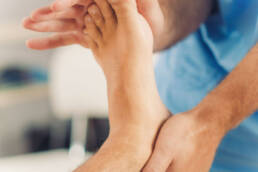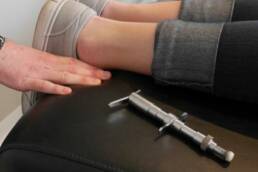According to the Journal of the International Association for the Study of Pain, nearly 1 in 3 people suffer from chronic pain. In many cases of chronic neck pain, back pain, and referred nerve pain, the source is some form of nerve compression, or what many call a pinch.
In many cases, the end result recommended by neurologists and orthopedists is surgery to relieve the compression. However, those surgeries are not only costly but also come with many associated risks, including further damage to the nerve. As you seek a solution for your pain, use this guide to understand nerve and spinal compression, what decompression is generally, and some natural ways you can decompress your spine without surgery.
What Is Spinal Compression?
Your spine is more than just the vertebrae and discs that make up your structural spine. It also includes the spinal cord, which is a bundle of nerves that transmits signals between your peripheral nerves and your brain. When you think about a pinch in your back, what you’re actually discussing is something pressing against that bundle of nerves.
This pressure is what is commonly referred to as spinal compression. The pressure can result from a disc or vertebra dislodging, or from something foreign pressing against it. The degree of compression as well as the location will determine the exact symptoms you feel.
What Causes Spinal Compression?
There are many possible causes of spinal compression. One of the more common is some form of injury, including auto accidents, falls, and sports injuries, to name a few. Scoliosis is an unusual curvature of the spine, and can also cause compression. Other causes include:
- Infection
- Spinal tumors
- Some bone diseases
- Rheumatoid arthritis
Symptoms of Spinal Compression
Because of the role the spinal cord plays, the symptoms of spinal compression can vary greatly. The one that gets the most attention is pain and stiffness in your back or neck, including the lower back.
However, there many other symptoms you may experience that may suggest an incorrect preliminary diagnosis. These symptoms may include:
- Burning or numbness in your extremities
- Loss of strength in your hands, arms, legs, or feet
- Trouble with coordinating movement
- Loss of libido
- Loss of bowel or bladder control
Clinicians diagnose spinal compression through a combination of diagnostic testing and clinical symptoms. Clinicians normally look for symptoms that suggest the underlying problem and then use imaging, such as x-rays, MRI or CT to confirm or further explore the significance of the issue.
How Does Decompression Work?
Spinal decompression works by relieving the pressure on your spinal cord. Effective decompression may include correcting structural shifts in your back, reducing inflammation, or addressing other underlying conditions.
Natural Spinal Decompression Options
Not all spinal compression needs to result in decompression surgery. Rather, there are multiple options for naturally decompressing your spine, including some things you can easily do at home.
Stretching
One of the best ways to stay on top of minor spinal compression is through various types of stretching. Some of the stretches that work well include:
Prone Pillow Decompression Stretch: Lay a pillow on a bed, and then lay on your stomach with the pillow under your pelvic region and your head and arms hanging off the end of the bed. Take long and deep breaths, holding the stretch for 30 to 60 seconds. Repeat the stretch 10 to 20 times, with a 1- or 2-minute break between stretches. Add additional pillows if you don’t feel the stretch.
Overhead Stretches: This is a simple stretch you can do anywhere. Stand with your feet shoulder-width apart, stretch your arms up and interlace your fingers, and push your palms toward the ceiling. Hold this for 10 to 30 seconds, however long is comfortable for you.
Prayer Stretch: Start by kneeling with your hands on the floor. Rock back so that your buttocks rest on your heels, with your arms straight out in front of you with your palms on the floor. Hold for 10 to 30 seconds based on your comfort level.
Cat and Camel Stretch: Start in the same kneeling position as the prayer stretch. However, this one only moves your back. Look down and roll your hips back to push your lower and middle back up and hold for 2 to 5 seconds. Now drop your back down and look up to push it down as far as possible and hold for another 2 to 5 seconds. Repeat about 20 times.
At-Home Devices
You may benefit from one of several at-home devices. One that gained a lot of attention several years ago is the inversion table, which uses gravity to relieve the pressure commonly caused simply by being upright. The challenge with these tables is that they can be difficult to use, especially when you’re by yourself. There are also various belts that provide external counter pressure to relieve the pressure on your spinal cord.
Clinical Decompression Therapy
You may also benefit from clinical decompression therapy from your chiropractor. For minor compression, your chiropractor may use the Flexion-Distraction technique, which gently manipulates the spine while the table moves.
In some cases, your chiropractor may recommend the use of a spinal decompression machine. This is a special type of traction machine that creates traction and relaxation. You will likely require multiple treatment sessions to get the relief you need.
Leave surgery as an option of last resort, and try the various methods to decompress your spine first. Take advantage of the spinal decompression special with the experts at Apex Chiropractic to begin relieving your pain today.

Ready to See the Best Chiropractor in Louisville, CO?
Apex Chiropractic believes in thriving through life, not suffering in it. We believe that the activities that we want to partake in do not only desire but are necessary, just as necessary as our daily activities. In order to thrive in life and not suffer, we have to be completely in tune with our bodies. Schedule your appointment with us, today.
Like this article? Spread the word!
Related Posts
April 6, 2023
Torque Release Technique Vs Traditional Chiropractic
Every Chiropractic Dr. has their own go-to method and strategy when relieving pain and…
April 5, 2023
Chiropractic Care Can Fix Your Check Engine Light
Is Your Check Engine Light On? Routine Chiropractic Care Treats the Source NOT the…
April 4, 2023
Why is “The Integrator” the best way to get a chiropractic adjustment?
The Torque Release Technique and the Integrator were recently developed and have allowed…





